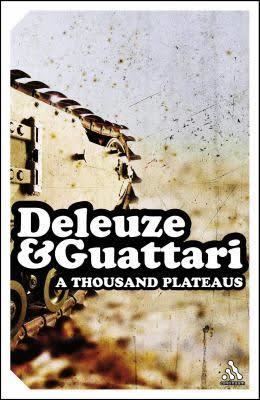8.6 /10 1 Votes8.6
Original title Mille plateaux Language French Originally published 1980 | 4.3/5 Goodreads Country France ISBN 978-0816614028 | |||||||||||||||||||||||||||||||||
 | ||||||||||||||||||||||||||||||||||
Media type Print (Hardcover and Paperback) Pages 645 (French edition)610 (English translation) Similar Gilles Deleuze books, Philosophy books | ||||||||||||||||||||||||||||||||||
1 of 3 a thousand plateaus by gilles deleuze f lix guattari illustrated audiobook
A Thousand Plateaus: Capitalism and Schizophrenia (French: Mille plateaux) is a 1980 philosophy book by French authors Gilles Deleuze and Félix Guattari, respectively a philosopher and a psychoanalyst. The authors draw upon and discuss the work of a number of authors, including Sigmund Freud, Carl Jung, and Wilhelm Reich. A Thousand Plateaus is written in a non-linear fashion, and the reader is invited to move among plateaux in any order. It is the second volume of Capitalism and Schizophrenia, and the successor to Anti-Oedipus (1972). Before the full English translation by social theorist Brian Massumi appeared in 1987, the twelfth "plateau" was published separately as Nomadology: The War Machine (New York: Semiotext(e), 1986). Though influential, and considered a major statement of post-structuralism and postmodernism, the book has been criticized on many grounds.
Contents
- 1 of 3 a thousand plateaus by gilles deleuze f lix guattari illustrated audiobook
- 3 of 3 a thousand plateaus by gilles deleuze f lix guattari illustrated audiobook
- Summary
- Reception
- References
3 of 3 a thousand plateaus by gilles deleuze f lix guattari illustrated audiobook
Summary
Deleuze and Guattari discuss concepts such as the Body without Organs, deterritorialization/reterritorialization, assemblages, smooth and striated space, and a range of subjects including semiotics and linguistics. They evaluate and criticize the work of Sigmund Freud, referring to the case histories of Little Hans and the Wolf Man. Deleuze and Guattari consider Carl Jung "profounder than Freud". They also assess the work of Wilhelm Reich, discussing Reich's ideas about "character armor" in his work Character Analysis (1933). Deleuze and Guattari also evaluate works of literature by a variety of authors, including Henry James' In the Cage (1898), F. Scott Fitzgerald's The Crack-Up (1945) and H. P. Lovecraft's "Through the Gates of the Silver Key" (1934), which they call one of his masterpieces. They also refer to Frank Herbert's science fiction novel Children of Dune (1976).
Reception
A Thousand Plateaus is considered a major statement of post-structuralism and postmodernism. Jean-François Lyotard commented, however, that he had "read in a French weekly that some are displeased with Mille Plateaux...because they expect, especially when reading a work of philosophy, to be gratified with a little sense." Mark Poster writes that the work "contains promising elaborations of a postmodern theory of the social and political." Writing in the foreword to his translation, Massumi comments that the work "is less a critique than a positive exercise in the affirmative 'nomad' thought called for in Anti-Oedipus." Massumi contrasts "nomad thought" with the "state philosophy...that has characterized Western metaphysics since Plato".
Deleuze critic Eugene Holland suggests that the work complicates the slogans and oppositions developed in its predecessor. Where Anti-Oedipus created binaries such as molar/molecular, paranoid/schizophrenic, and deterritorialization/reterritorialization, A Thousand Plateaus shows how such distinctions are operations on the surface of a deeper field with more complicated and multidimensional dynamics. In doing so, it also moves away from human history toward topics such as biology and geology. Massumi writes that A Thousand Plateaus differs drastically in tone, content, and composition from Anti-Oedipus. In his view, the "schizophrenia" the authors embrace is not a "pathological condition", but a "positive process" that involves "inventive connection". Bill Readings appropriates the term "singularity" from A Thousand Plateaus, "to indicate that there is no longer a subject-position available to function as the site of the conscious synthesis of sense-impressions." Sociologist Nikolas Rose writes that Deleuze and Guattari articulate "the most radical alternative to the conventional image of subjectivity as coherent, enduring, and individualized".
Physicists Alan Sokal and Jean Bricmont argue in Fashionable Nonsense (1997) that A Thousand Plateaus contains many passages in which Deleuze and Guattari use pseudo-scientific language. Author Janet Murray links the work to the aesthetic of hypertext. Author Espen Aarseth equates Deleuze and Guattari's idea of the rhizome with semiotician Umberto Eco's idea of the net. A Thousand Plateaus was an influence on political philosophers Michael Hardt and Antonio Negri's book Empire (2000). Sociologist John Urry sees Deleuze and Guattari's metaphor of the nomad as having "infected contemporary social thought." Philosopher Manuel DeLanda, in A New Philosophy of Society (2006), adopts Deleuze's theory of assemblages, taken from A Thousand Plateaus. Christopher Miller and Timothy Laurie criticize Deleuze and Guattari's use of meretricious anthropological sources to buttress claims about nomadism. Laurie also describes Deleuze and Guattari's commentary on "becoming-animal" as "leading", insofar as it "naturalizes what is an otherwise spurious distinction between that which attracts narcissistic Oedipal investments and that which does not".
Philosopher Roger Scruton dismisses A Thousand Plateaus as "nonsense" and "unreadable".
